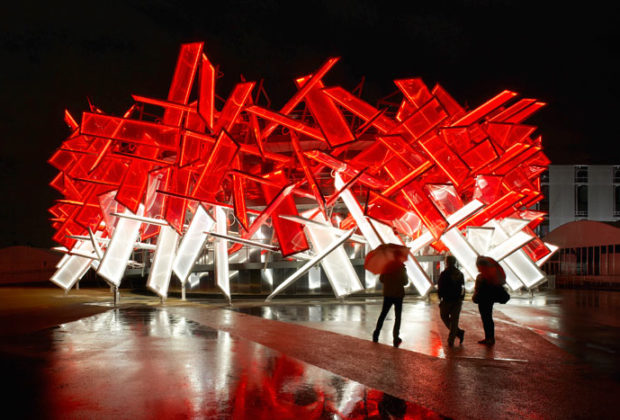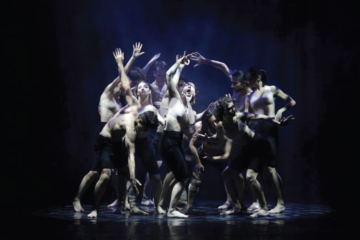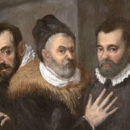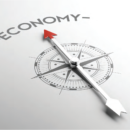
World’s most important biennales and triennales
Venice Biennale
– The most famous contemporary art scene is active for more than a century
Started: 1895
How often: every 2 years
Previous edition: the 56th, in 2015
Previous edition`s curator: Okwui Enwezor
Participating countries: 88
Artists: more than 150
Public presence: over 475.000 visitors
Venice Biennale was founded in 1895, and is currently the most famous and complex international cultural event containing most of
the artistic domains. The biennale is the core for researches and the promotion of new contemporary art trends. It is organizing exhibitions and documentations in all its specific fields: art (since 1895), architecture (since 1980), cinema (since 1932), dance (since 1999), music (since 1930) and theater (since 1934).
Starting with 1998, since Paolo Barrata has taken over the management, the art and the architecture biennales are no longer simple exhibitions organized through the contribution of the National Pavilions, but they are built on three important pillars: the National Pavilions exhibitions, each having its own curator and project; the International Exhibition managed by the curator of the Biennale, who was specifically selected for the task; other associated events, approved by the Director of the Biennale.
Venice Art Biennale was recognized as the global leader of contemporary art exhibitions, and the number of participating countries increased from 59 in 1999 to 89 in 2015. The Architecture Biennale is well recognized as well.
Starting with the second edition, the Venice Biennale has introduced some novel elements, such as the Critics Award. This award acted as an incentive for the publishing of articles and analyses which have determined the increase of the event’s visibility and quality, the launch of some works which became famous (for example Giuditta II by Gustav Klimt), the display of the 1930s French paintings – landscape artists Corot and Miller -, and the personal exhibition of Auguste Rodin. The fifth edition also introduced decorative arts and the Hall of Refusals.
Documenta –
Transforming universal art –
Started: 1955
How often: every 5 years
Future edition: the 14th, during 8th of April 2017 – 16th of July 2017 in Athens and 10th of June 2017 – 17th of September 2017 in Kassel
Future edition`s curator: Adam Szymczyk
Theme: Learning from Athens
Artists: approximately 300
Public presence: 905.000 visitors (in 2012)
Documenta was instituted in 1955 by painter and professor Arnold Bode, and it is today, together with the Venice Biennale, one of
the most important international events displaying modern and contemporary art, despite the fact that it happens every 5 years in the small town of Kassel. It is perhaps one of the few events that have preserved their unique character to the present day; because it reinvents itself with each edition and because it is managed by different specialists each and every time. At first, the goal was to fight the interdiction imposed by the Nazis on the so-called decadent art and to unify the country which was politically divided from a cultural perspective. Therefore, Kassel was not chosen by accident, as it is the located in the heart of Germany.
After the imposed Nazi dictatorship and cultural darkness, there was a desire to reconcile the German public, and to transpose it again into the modern international artistic vibe. This favored the development of the most important artistic movement starting with the first decades of the 20th century: fauvism, expressionism, cubism, Der Blaue Reiter group, futurism and Pittura Metafisica. Arnold Bode displayed the value of artworks in the ruins of the Fridericianum Museum and today, the main building is hosting the Documenta events. He is also the one who named the exhibition, Documenta, a suggestion to the term which refers to documents, evoking the significance of certain events aiming to explore modern art.
The first edition focused on the 1920 – 1930s abstract art displayed important artists such as Picasso and Kandinsky. In time, the exhibition focused more and more on contemporary art. Between 1955 and 1992, Documenta was exclusively hosted by the Fridericianum Museum in Kassel; since 1992 architects Jourdan and Müller have conceived a special exhibition hall for this event. The space has more than 1.4000 (14.000?) square meters and hosts other events and conferences throughout the year.
Yet, the exhibition doesn’t have a strict and limited space and it tends to expand all over the city. For example, in 2012, 30 artists haves displayed their works in open air, at Auepark. The tree – sculpture by Giuseppe Penone was installed there in 2010, also People walking toward the sky – a sculpture from 1992 created by Jonathan Borofsky or 7.000 oaks by the German artist Joseph Beuys – were all absorbed by Kassel`s landscape.
Joseph Beuys had a key role in shaping the political perspective of Documenta: he pleaded with a lot of conviction for a format that would equally respect both ideas of inclusion and difference, whilst attempting to break down the euro centered approach of the exhibition. Worrying that the artists and the public were perceiving culture from an exclusive western perspective, he has transformed Documenta into a platform that provides a global representation of culture. Okwui Enwezor, the first director of African origin, has embraced Beuys` multicultural initiative and explored it through the project called Platform 5. Therefore, the ninth edition raised a debate regarding the manner in which contemporary art handles the numerous cultural, social and political divergences and all the institutional transitions, transformations, cracks and consolidations at global level.
During the last editions, Documenta has expanded in the entire city, using 32 locations (for the 2012 exhibition). Unlike most large scale artistic events, Documenta stands out due to the curator`s approach – very much intellectual – that raised debates among the specialized critics. Documenta doesn’t throw so many dinners and parties – which provide more charm to the other exhibitions of this sort. Nevertheless it succeeds to gather a very large public, generating ideas and creating enthusiasm among modern artists. Art critics have drawn attention to some barriers that exist towards the public at large because of the message with highly elevated content and concluded that, if we desire a wide social change, then we need to dilute the intellectual-esoteric messages in order to ease the access of a larger public.
Manifesta
Started in: 1996
How often: every 2 years
Current edition: 11th, 11.06.2016 – 18.09.2016, in Zurich
Current edition`s curator: Christian Jankowski
Theme: What people do for money – some joint ventures
Participating countries: over 40
Public presence: over 2.5 million visitors in 20 years
Manifesta is an itinerant contemporary art exhibition taking place every 2 years; it started in 1996, each time in a different city: Rotterdam (1996), Luxembourg (1998), Ljubljana (2000), Frankfurt (2002), San Sebastian (2004), Nicosia (2006 – cancelled), Trentino – South Tirol (2008), Murcia in partnership with Northern Africa (2010), Limburg (2012), St. Petersburg (2014), Zurich (2016), Palermo (2018).
Manifesta is different from the usual centers of artistic production and attempts to suggest a fresher cultural vibe. This means innovations brought to the curatorial practices, and the models of exhibition and education.
Each edition contains a series of activities that last two or even more years. These events include publications, meetings, discussion and seminars which take place in various locations throughout Europe and the neighborhood areas, and wrap with a three month exhibition in the host-city. Therefore, Manifesta creates a doable interface between international artistic and intellectual debates, focusing on the qualities and the particularities of the given place.
For the first time in its history, the European biennale of contemporary art is managed by a single artist. Christian Jankowski was elected as curator in order to create a socio-political and cultural portrait of the city of Zurich. His concept brings together international and local artists from various professional fields. From a list of more than one thousand professions, the thirty participating artists were asked to choose a job that they consider to be the most inspiring for themselves. Next, the team led by Christian Jankowski selected the representatives who are most suited for the profession they chose to act as «hosts» and presented them to the artists. They spend time together and develop a relationship that aims to create artwork. A part of these results is being displayed right where the action takes place and another part is installed within artistic institutions around the city. The theme of this year`s edition is a collective experiment, the identity of the city, focused on the relationship between the artistic production / creation and the work, as seen in its most various significances.
Each joint-venture takes place in three locations: an art institution, a place dedicated to art; a satellite space, close to the workplace of the host; the Pavilion of Reflections, created especially for Manifesta 11, where each project is to be presented as a movie. Further, during this edition, Cabaret Voltaire, the birthplace of dadaism, is to be transformed into a scene for the groups` performance.
Sao Paulo Biennale
Started: 1951
How often: every 2 years
Current edition: the 32nd, 07.09.2016 – 11.12.2016
Current edition`s theme: Incerteza Viva (Live Uncertainty)
Current edition`s curator: Jochen Volz
Participating countries: 33
Artists: 81
Public presence: a total of approximately 8 million visitors (until the 32nd edition).
Started in 1951, the Sao Paulo Biennale is the second oldest biennale after Venice which was, in fact, its source of inspiration. Founded by the Italian-Brazilian businessman Ciccillo Matarazzo (1898 – 1977) in 1957, the Biennale took place in the 30.000 square meters pavilion in Parque do Ibirapuera that he owns and was designed by Oscar Niemeyer and Hélio Uchôa. The place is also hosting the greatest art fair in the country, SP-arte.
In 1962, the Sao Paulo Biennale`s Foundation was set up and took over the organization of the Biennale that was, until that point, under the management of the Sao Paola Modern Art Museum (MAM – SP). Since the beginning, the objectives of the Biennales were to make contemporary art known in Brazil, to ease the access of Brazilian people to the international art scene and to make Sao Paola (e Sao Paola sau Paolo?) an important art center. The Biennale brings Brazilian art closer to the international public and vice-versa.
The current edition identified its theme and title in Brazil’s reality – loss of hope and uncertainties – against severe recession, political instability and the highest inflation rate in the last 12 years. “Art feeds with uncertainty, good luck, improvisation and gossips. We seek to understand diversity, to look at the unknown and to doubt the things we assume we know. We regard the various sciences of the contemporary world as being in a relationship of complementarity and not one of exclusion”, says the curator of this year`s Biennale, Jochen Volz. The concept of uncertainty is part of the various disciplines repertoire – from mathematics to astronomy, going through linguistics, biology, sociology, anthropology, history and education. Unlike what goes on in other fields, the uncertainty in art suggests disorder, taking into consideration ambiguity and contradiction.
Whitney Biennale –
The American art show –
Started: 1932
How often: every 2 years (for a while it took place annually)
Future edition: the 78th, in 2017
Future edition`s curator: Christopher Y. Lew and Mia Locks
Participating countries: 13
Artists: over 150
Public presence: more than 475.000 visitors
The most important exhibition in the United States of America, the Whitney Biennale is mostly dedicated to young artists, less known to the public, who display at the Whitney American Art Museum in New York. The series of events was started by Gertrude Vanderbilt Whitney in 1932. At first it was as an annual exhibition, and in 1973 it became a biennale. At the beginning of this year, the museum has announced that the exhibition of 2016 would be pushed to 2017 in order to allow the curators` team to adapt the project to the new museum building. The Whitney building in Manhattan Meatpacking District was designed by architect Renzo Piano, and it includes approximately 50.000 square meters of interior galleries and 13.000 square meters of open air space and terraces. The event hosted by the asymmetric building made from steel and concrete is the best barometer of the American art market.
Carnegie International
Started: 1896
How often: between 3 and 5 years
Previous edition: the 56th, in 2013
Previous edition`s curators: Daniel Baumann, Dan Byers and Tina Kukielski
Future edition: 57th, in 2018
Future edition`s curator: Ingrid Schaffner
Participating countries: 19
Artists: 35
Public presence: more than 150.000 visitors
When the American industrialist Andrew Carnegie had founded Carnegie Institute in 1895, one of his daring ambitions was to create a modern art museum, as part of the Institute. The series of exhibition he had created became the core of this system. Carnegie used the exhibition for attracting the world of art to Pittsburgh and above everything else, to build a permanent collection by purchasing “the great masters of tomorrow”.
Just one year after the first Venice Biennale, the 1896 launch exhibition displayed the works of some great modern artists, from Vincent van Gogh, Auguste Rodin and James Whistler to Nicole Eisenman, Frances Stark and Phyllida Barlow. The event was held every three or five years and it evolved from a pedagogical initiative meant to present the world’s best artworks to the American public to an opportunity for some of the greatest artists to gain international recognition.
The Carnegie International remained constant in time, but had several formats. In 1896, the exhibition was conceived as an annual introspection and was presented as an Annual Exhibition. Up to 1927, when Henri Matisse won the first prize and his true recognition as a modern artist was confirmed, only few vanguard works were displayed in these exhibitions. No earlier than the 1950s did Carnegie International develop as an influential display of vanguard art and thus proved a significant evolution. Many works signed by the greatest European artists were purchased for the museum’s collections from the international exhibitions of those times. In 1950, the exhibition became a biennale and in 1955 a triennale. Carnegie International was reinstated as main documentation of contemporary art in the United States of America at the famous 1985 (the year when the Carnegie Award was launched), 1988 and 1991 exhibitions. Since 1963, the Institute became Carnegie Museum of Art.
The 2013 edition was conceived at first by a team of 3 curators and it had three main themes meant to create a direct dialogue between art and spectators: a rich exhibition on the architecture of post-war playgrounds, displayed in a playground placed in front of the Museum`s entrance; an ambitious reinterpretation of the permanent modern and contemporary art collection of the Carnegie Museum exploring the history and the heritage of the Carnegie performances, thus expanding the perspective of including the suburbs of Pittsburgh – the host city-into the exhibition’s circuit.
Sharjah Biennale (United Arab Emirates)
Started: 1993
How often: every 2 years
Previous edition: 12th, in 2015
Theme: The past, the present, the possible
Previous edition`s curator: Eungie Joo
Participating countries: 25
Artists: more than 50
Public presence: 90.000 visitors
Next edition: March-June 2017
Curator: Christine Tohme
The United Arab Emirates has experienced an explosion of its art institutions during the last decade, yet the Sharjah Biennale is one of the oldest cultural events in the region, launched in 1993. From a traditional, regional exhibition it became an internationally recognized event. The Biennale was founded by the Sharjah Department of Culture and Information, and since 2009 was taken over by Sharjah Art Foundation which is also organizing additional visual art programs.
Each edition is organized around a theme that can be either conceptual, like in 2011 – curators Suzanne Cotter and Rasha Salti, together with Haig Aivazian chose the theme “Plot for a Biennial” with a narrative speech – either obviously political, like the 2007 edition and its theme called “Still Life:. Art, Ecology and the politics of change“. Sharjah Biennale is always maintaining a balance between its international character and the specific particularities of the Arab world, attracting top curators like Eungie Joo.
Istanbul Biennale
Started: 1987
How often: every 2 years
Previous edition: the 14th in 2015
Previous edition`s curator: Carolyn Christov-Bakargiev
Participating countries: 33
Artists: 88
Public presence: more than 115.000 visitors (in 2015)
Started in 1987, the first two editions of the Istanbul Biennale were organized by Beral Madra, a local curator and critic, and had a global approach and a typical structure, reuniting thus a few dozens of international artists.
In 2012, The Istanbul Culture and Art Foundation (č°KSV) has launched the first design biennale that aims to explore a wide area of fields, from urban architecture studies to industrial design, graphic design, fashion and other relevant creative disciplines.
Being of the most important cultural crossroads of the world, Istanbul has benefited a long time from the activity of many important curators who were attracted by the strategic location of Turkey between Europe, Asia and the Middle East.
Lyon Biennale
Started: 1991
How often: every 2 years
Previous edition: the 13th edition in 2015 – 2016
Current edition`s curator: Thierry Raspail
Artists: 52
Public presence: more than 200.000 visitors
Launched in 1991 by Thierry Raspail, the director of the city’s Contemporary Art Museum Lyon Biennale, this is one of the first events of its kind in France. The curators have approached time after time some existential subjects such as exoticism (Jean-Hubert Martin, 2000), temporality (Le Consortium de Dijon, 2003) or time (Nicolas Bourriaud and Jérôme Sans, 2005), who function as theme key concepts selected by Raspail. The period 2015-2019 focuses on “modernity”. It was opened by Ralph Rugoff, the director of Hayward Gallery in London and shall be continued in 2017 by Emma Lavigne, on the same theme. Each edition of the Lyon Biennale is an opportunity to explore a specific theme – history, globalization, time, etc.
Havana Biennale
Started: 1984
How often: every 2 to 3 years – although it was a biennale up to 2012, in 2013 they announced that the 2014 edition is postponed until the following year and that the exhibition is to be organized every three years.
Previous edition: 12th edition, in 2015
Previous edition`s curator: Havana’s Wifredo Lam Contemporary Art Center team
Theme: Between the Idea and Experience
Participating countries: 45
Artists: 180
Started in 1984, Havana Biennale stands out due to the exclusivist attention paid to the non-western artists. The first edition has included only Caribbean and Latin American artists and in the later editions it became open also towards Middle Eastern, African and Asian artists. Among the specific features of the Havana Biennale there is also its curatorial policy: each edition is coordinated by a managerial team from the Contemporary Art Center Wifredo Lam in Havana, unlike all other biennales that are permanently selecting famous curators. Therefore, Havana Biennale is not always following the common path of similar events. The selection is done through direct invitation sent to the artists and it is not an open contest.
The particular subjects approached by this Biennale were: the existing tension between tradition and the contemporary world, the historical colonization processes, the relationships between art and society, the individual and his memory, the human communication faced with technological development and the dynamics of urban culture.
Berlin Biennale
Started: 1996
How often: every 2 years
Current edition: the 9th, in 2016
Current edition`s curator: the DIS group (Lauren Boyle, Solomon Chase, Marco Roso, David Toro)
Established in 1996 by Klaus Biesenbach, the Director of the Contemporary Art Institute KW and a group of art collectors, the Berlin exhibition is also inspired by the Venice Biennale model. Berlin is one of the cultural capitals of the world, and, first and foremost, it draws the attention on young artists and to a smaller extent it is a large thematic performance. We can see it as an art lab, where the newer artists are given the opportunity to become known to the public at large.
Sydney Biennale
Started: 1973
How often: every 2 years
Current edition: the 20th, in 2016
Theme: The future is already here — it’s just not evenly distributed
Current edition`s curator: Stephanie Rosenthal and the managerial group Attaches
Artists: over 1.600 artists from beginning and up to the present time, coming from more than 100 participating countries
Public presence: 665.000 visitors (in 2014)
Sydney Biennale is the biggest and the most interesting visual art event in Australia. It presents a 3 month exhibition accompanied by many associated events: meetings with the artists, forums, performances, guided tours with free access and projects of general interest held in many locations around Sydney, in conventional places: the Contemporary Art Museum and the New South Wales art gallery and also the Royal Botanic Gardens or even a former hail house on Cockatoo island, some restored canyons in Walsh Bay and the Sydney Opera.
DAK`ART
Started: 1992
How often: every 2 years
Current edition: the 12th, in 2016
Current edition`s curator: Simon Njami
Artists: 65 from 24 countries
Current edition’s theme: The city in the blue daylight
It was initially conceived in 1989 as a biennale that would alternate visual art and literature. In 1996, the Dakar Biennale fully committed to African contemporary art. This year
DAK’ART edition has celebrated a series of important African artists who passed away in the last 6 months: Oumar Ly (Senegal), Souleymane Keita (Senegal), Amadou Sow (Senegal), Ismaila Manga (Senegal), Sidy Diallo (Senegal), Leila Alaoui (Maroc) and Kiripi Katembo (Congo). Further, the exhibition desires to display the international features of African arts inspired by the particularities of its culture. The exhibition contains African sculptures and postmodernist forms, as well as exhibitions of tribal traditional art.
Liverpool Biennale
Started: 1998
How often: every 2 years
Current edition: the 9th, in 2016
Artists: 44
One of the most important events in the United Kingdom is closely linked to the reinventing of a city that provides many abandoned, empty, excellent and uncommon spaces for displaying art exhibitions. Among these we mention the spectacular work of Richard Wilson, Turning the Place Over (2008), for which the artist has cut and twisted the facade of a ruined building. The Biennale explores fictions and stories, offering the spectators a visual journey in time and space, making a sketch of the city’s past, present and future.
Shanghai Biennale
Started: 1996
How often: every 2 years
Current edition: the 11th, during 2016 – March 2017
Theme: Why not ask again?
Shanghai Biennale provides an international exchange of ideas and reunites artists, curators, writers, ideologists and art supporters from all over the world. The Biennale has become a critical space of dialogue within a market that is continuously expanding. Besides this, the biennales emphasizes the important role of artistic production in the Asian- Pacific region.









